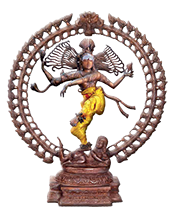உ
Pluralistic Philosophy of Saiva Siddhanta -1
Dr. K. Ganesalingam
The view of Wikipedia relating to Saiva Siddhanta given is not at all a fair representation. Hawaii Adheenam gave incorrect interpretation to Thirumanthiram verses and found monism in Saiva Siddhanta. Its attempt to convert Saiva Siddhanta as a monistic philosophy was ably refuted by V.K. Palasundaram, Chairman, Saiva Religion Advisory Committee, Selangor/Wilaya Persekuan Ceylon Saivites Association, KL, Malaysia through two of his books. One book is “There has always Been a PLURALISTIC saiva Siddhnata Philosophy” (1984) and the other is “Souls are Beginningless” (1983). Other Siddhnata scholars like Pandit Dr Mu. Kanthiah of Earlalai of Sri Lanka also wrote about it. It is high time the Siddhanta scholars work to edit the controversial and incorrect views of Wikipedia. I will first attempt to explain the pluralistic nature of SS as seen in Thirumurai works including Thirumanthiram, ancient Tamil literatures, Yogaswamy’s words etc., in my postings to follow. Yogaswamy was the Guru of the Subramunya Swami, the founder of Hawaii Adheenam. I kindly appeal to the SS scholars to make their contributions to help Wikipedia to edit its related views.
Saiva Siddhanta as a pluralistic philosophy was well established centuries ago. However, the question whether it is monistic or pluralistic emerged in 1980s when Satguru Sivaya Subramuniyaswami, Founder- Head of Kauai Adheenam in Hawaii, presented his view that it is a monistic philosophy.
Many Siddhanta scholars have refuted this view. Recently Rajaratnam Chandrasegaran has been writing in these columns analyzing and proving that Saiva Siddhanta is a pluralistic philosophy. As he says, ‘He (Sivaya Subramuniyawami) is logical in all, except for the divine origin of the soul’.
School of Kauai Adheenam
Satguru Subramuniyaswami had his own reasons for coming to his conclusion when he asserted, “There can be only one final conclusion, and that is monistic theism”. His analysis and conclusion about Saiva Siddhanta as a monistic philosophy is seen in his book ‘Dancing with Siva’. There is a chapter (Resource 4) “Monism And Pluralism In Saiva Siddhanta” in the on-line book. This chapter has another title in the 1993 edition of the book, but the subject matter remains same, with some difference in presentation, in this edition.
According to the Swami, ‘There are two Saiva Siddhanta shools: pluralistic theism, in the lines of Aghorasiva and Meykandar, and Thirumoolar’s monistic theism. While differing lightly, they share a religious heritage of belief, culture and practice’. He has identified the common areas where the pluralists and monists agree and correctly stated that they were ninety five percent of what constitute Saiva Siddhanta. The disagreement of five percent is on his monistic view as opposed to the accepted traditional pluralistic view of Saiva Siddhanta.
He also says, “While monistic theists, Advaita Isvaravadins, view the 2,200-year-old Thirumantiram as Siddhanta’s authority, pluralists, Anekavadins, rely mainly on the 800-year-old Aghorasiva’s Paddhatis and Meykandar Sastras”. With this wide difference of time period of these authorities for monistic and pluralistic schools, he states that a philosophical debate between the two schools was continuing for twenty centuries and more. Obviously it is not a logical statement. His related statement is as follows:
“The purpose of this resource section is to present the monistic Saiva Siddhantha philosophy – sometimes known as Advaita Siddhantha or Advaita Ishvaravada – and to juxtapose it briefly with pluralistic Saiva Siddhanta or Dvaita Siddhanta. This comparison is important because the pluralistic teachings are widespread, so much so that many authoritative texts proclaim Saiva Siddhanta to be wholly pluralistic and completely overlook the monistic school, which is actually far older, though less well known. Between these two schools there continues a philosophical debate that has persisted for twenty centuries and more about whether God and soul are ultimately one or two”.
He accepts that ‘many authoritative texts proclaim Saiva Siddhanta to be wholly pluralistic’. However, he advocates the monistic school, in disagreement with these authoritative texts.
Pattatis and Meykandar Sastras
Saiva agamas are, in general, classified into two parts. One is the karma kanda (ritual part) which includes sariya, kriya practices in Saivism. The other is gnana kanda (knowledge part) which includes yoga and gnana in Saivism. Generally both parts are sometimes considered as Saiva Siddhanta which, in reality, is based on the gnana kanda.
Those who wrote books on karma kanda, with details of Saiva practices relating rituals and worship in temple and home are called Karma Sidhanta Kuravars (kuravar – teacher). Pattatis (Paddhatis) are books written by them. Those who wrote books on gnana kanda, dealing with details of pati, pasu and pasa are called Gnana Siddhanta Kuravars. Their books relate to Saiva Siddhanta philosophy. Meykanda Sastras are such books.
Details of rituals in Agamas are sometimes found incomplete, and without continuity and clarity. Pattatis give these details arranging them in order. In a way they help the maintenance of agamas without their going into oblivion. Pattatis are called by the name of their authors. Agorasivachariyar Pattati and Somasambu Pattati are most popular pattatis in the Saiva world.
It is said that eighteen pattatis are available now. They were published by the Sivagama Sangam of Devakottai, Tamil Nadu, India. Text of two pattatis is published in the name of ‘Civpuja Pattati’ by Tanjavur Saraswathy Makhal Noolaka Sangam in 1988. It is about rituals and ceremonies for worship Lord Siva.
Pattati means series, row or range. It is a manual of ritualistic rules. Hence pattatis cannot be considered as authorities for Saiva Siddhanta philosophy. Adheenam’s statement about pluralistic Saiva Siddhanta in the line of Agorasivam’s pattati is therefore misleading. Meykanda sastras are the authority for Saiva Siddhanta, and the pluralistic school of Saiva siddhanta is in the line of Meykandar.


